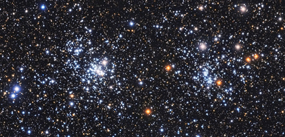Brief Syllabus
Download & Print [pdf]
The full, detailed syllabus is accessible as a pdf - here.
AST 352K – STELLAR ASTRONOMY
FALL 2013, UNIQUE NO. 48555
Main course website: www.as.utexas.edu/astronomy/education/fall13/dinerstein/352k.html
Class meetings: TTh 12:30-2 PM, RLM 15.216B
Instructor: Prof. Harriet Dinerstein, 512-471-3449, harriet@astro.as.utexas.edu
Prof. Office Hours: TBA, RLM 16.324
Weekly Help Sessions: W 4-5 PM, RLM 13.132
Teaching Assistants:
|
Brian Mulligan |
Intae Jung |
COURSE LEVEL & CONTENT:
Astronomy 352K is an upper-division course on stellar astronomy that approaches the subject from the perspective of how we obtain and interpret astronomical measurements in general. It is designed for undergraduates majoring in astronomy or physics or similar fields such as engineering, although students in other science majors should be fine as long as they have the prerequisites.
Stars are obviously fundamental to the field of astronomy: after all, the very name means “study of the stars.” They are the ruling bodies of planetary systems, the building blocks of galaxies, and the nuclear ovens in which the elements heavier than helium were created. We will approach the subject the way professional astronomers do, by examining so-called “observable” properties of stars. These are quantities that can be even measured from great distances, through detailed and quantitative characteristics of their emitted light. By applying relevant physical principles, we will study how to deduce temperatures, radii, luminosities, composition, masses, etc. of stars from such measurements. Appreciating the power and limitations of these methods is one of the main goals of this course, as well as understanding the properties and life histories of stars and their role in the universe at large.
PREREQUISITES & BACKGROUND:
The prerequisites are Physics 316 and 301 or equivalents, and the corresponding math courses. However, astronomy draws on many specialized topics in physics and we will introduce these as we go along. The purpose of the prerequisite is to ensure familiarity with physical principles and practice at working problems. Our main interest in this course lies in applying physical principles rather than in carrying out derivations from scratch, and the math we will use will mostly be at the level of algebra, trigonometry, and simple calculus.
Some of you have previously taken an introductory astronomy course such as Ast 307, 301, or the equivalent. This is not a requirement, although such students may have the advantage of greater familiarity with astronomical terms. If you have not taken such a class and feel the lack of such background, feel free to consult most any introductory textbook (one of my favorites will be on reserve in PMA library). I will conduct a survey at the first class meeting to assess the backgrounds of students enrolled this semester, although I expect that there will be a broad range in experience.
TEXT & RESOURCES:
The primary text for Ast 352K is a set of Course Notes that were developed collaboratively by Profs. Dinerstein and Sneden over many years. Small changes and updates are incorporated each year. You will be able to download the notes one section at a time as pdf files from the course website or Blackboard. To comply with “fair use” policies and copyright laws, these notes are for your personal use only; they may not be distributed (or resold for profit!) to any outside parties.
COURSEWORK & GRADING BASIS:
The required coursework will include a number of homework assignments, three hour exams, and a term research paper on a relevant topic approved by the instructor. You are also expected to attend class regularly. The third hour exam will be given during the designated final exam time, Friday, December 13, 2-5 PM.
Grading Basis: Course grades will use the plus-minus (A−, B+, etc.) scale.
Hour Exams: 3 in-class exams, 20% each; total = 60% of the course grade
Dates: Oct. 3 (definite), Nov. 7 (subject to change), Dec. 13 (definite)
Homeworks: Up to 6 problem sets, lowest to be dropped = 15%
Due dates: Homeworks due Thursdays at the start of class.
Help sessions: Wed. afternoons, Office hours: see above.
Term Paper: 6-8 page research paper = 15%
Due on the last class day, Thurs., Dec. 5.
Participation: Regular attendance and in-class activities = 10%
Attendance will be taken via sign-in sheets. Missing an excessive number of classes will result in the loss of participation credit, and possibly filing of an “absence/failing” report.
TOPICS:
The following is a list of topics typically covered in Ast 352K.
I. Introductory Remarks; Positional Astronomy (locating and tracking objects on the sky)
II. Properties of Electromagnetic Radiation (radiation quantities, blackbody radiation)
III. Photometry: Measuring Stellar Brightness (definitions, uses, photometric systems)
IV. Effects of the Earth’s Atmosphere on Astronomical Observations
V. Observational Tools and Techniques (more than just telescopes!)
VI. Spectroscopy and Stellar Spectra (a mostly empirical approach)
VII.A. Interpreting Stellar Spectra (the theoretical basis)
VII.B. Spectra of Gaseous Nebulae (similarities & differences from stellar spectra)
VIII. The Hertzsprung-Russell Diagram (the Rosetta Stone of astronomy)
IX. Stellar Motions and Orbits
X. Binary Stars (the key to stellar masses)
XI. Stellar Evolution (capsule review of stellar aging and endings)
XII. Other Possible Topics (if times permits; topics to be determined)
STELLAR ASTRONOMY LAB, AST 152M:
Simultaneously with Ast 352K, the Astronomy Department offers a 1-credit-hour laboratory course, Ast 152M. The lab class is optional, and typically has a smaller enrollment than 352K. If you want hands-on experience taking and processing astronomical data, you should take Ast 152M. You will use the 16-inch telescope on the roof of RLM with a CCD detector to take data, and learn to analyze it with standard astronomical software packages such as IRAF. The website for Ast 152M is https://www.as.utexas.edu/astronomy/education/fall13/dinerstein/152m.html.
The initial organizational meeting for Ast 152M will be held in the last 15 minutes of the Ast 352K class meeting on Thursday, Aug. 27.

DNGC 869 and 884: Double Star Cluster in Perseus
(h + Chi Persei) [V. Souglakos]
Professor
RLM 16.324 · (512) 471-3449 · email
Office Hours
TBA
TA
Brian Mulligan
TA
Intae Jung